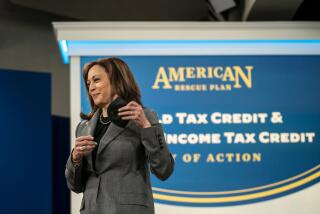House Panel Unveils New Tax Plan : Proposal Calls for Major Changes in Reagan Package
WASHINGTON — The House Ways and Means Committee Thursday revealed a new tax revision plan, endorsed in general by Chairman Dan Rostenkowski (D-Ill.), that calls for significant changes in President Reagan’s package and is expected to play a major role in shaping whatever bill finally emerges from the House.
The staff-written package would provide middle-income taxpayers with a slightly more generous tax cut than in Reagan’s plan but would be substantially less generous to the $100,000-and-up bracket.
The staff’s plan, delivered as committee members went behind closed doors to begin a several-week effort to write a tax bill of their own, would also keep some of the state and local tax deduction, increase the capital gains tax, expand taxation of fringe benefits and diminish business tax write-offs.
Aimed at ‘Excessive’ Breaks
Rostenkowski, telling reporters “the staff wouldn’t put something in that I wouldn’t propose,” said the new plan is aimed at “guaranteeing that all profitable corporations will pay tax,” and that those at the upper end of the income scale give up “excessive tax breaks.”
But in many ways, the Ways and Means package conforms to the White House’s basic approach: reducing individual and corporate tax rates while limiting a host of tax breaks. The Rostenkowski-endorsed package accepts Reagan’s idea of telescoping today’s multiplicity of individual tax brackets--with a top rate of 50%--into three brackets of 15%, 25% and 35%, and it proposes to reduce income taxes for individuals by an average of 10%.
And like Reagan’s, the new proposal would theoretically raise as much tax revenue as the current tax code.
$120 Billion in New Taxes
The staff’s plan expands the average tax cut for most taxpayers earning less than $75,000. An average taxpayer with income between $20,000 and 30,000, however, would receive a slightly less generous tax reduction of 8.9%, instead of the 9.3% proposed by Reagan.
Like the White House proposal, the new plan calls on business to pay more than $120 billion in additional taxes over the next five years. But the money would be raised in different ways.
The Ways and Means plan cuts the 46% maximum corporate rate to 35%, instead of 33%, abandons Reagan’s controversial plan to “recapture” windfall gains from lower corporate tax rates, trims write-offs for future investments and phases in over 10 years the proposed 10% deduction for dividends paid to stockholders.
Members of the tax-writing committee reacted cautiously to the staff-prepared proposal, and few appeared ready to alter their positions without making changes of their own in the overall tax bill.
“The pot’s been stirred but I don’t know if it’s edible yet,” said Rep. William M. Thomas (R-Bakersfield). “Those who were opposed haven’t been picked up, and those who were for it haven’t gotten off.”
Many provisions of the new package depart in important ways from Reagan’s proposal. Among the areas are:
--State and local taxes. Reagan would repeal the deduction entirely, but the committee’s staff offered a complex proposal designed to alleviate some of the pain for those who live in states such as California and New York, where state taxes are high, as well as helping those from low-tax states.
Property Tax Deduction
The deduction for sales and personal-property taxes would be repealed, but a taxpayer could deduct either $1,000 worth of income and real-property taxes or the portion that exceeds 5% of adjusted gross income, whichever is greater. The change, according to staff estimates, would scale back the impact of Reagan’s proposal by about one third.
--The personal exemption and standard deduction. Reagan would raise the personal exemption, currently $1,040, to $2,000 next year and expand the “zero bracket amount”--a standard deduction for taxpayers who do not itemize their deductions--from $2,480 to $2,900 for singles and from $3,670 to $4,000 for couples.
By contrast, Rostenkowski’s staff would raise the personal exemption to $1,500 next year and, for non-itemizers only, would create a standard deduction of $3,550 for singles and $6,000 for couples in 1987. For each additional dependent, as well as for taxpayers who are elderly or blind, the standard deduction would be increased by $500.
--Two-earner deduction. The committee plan, like Reagan’s, would drop the deduction, but it would largely offset the “marriage penalty” in the tax system by restructuring tax brackets and rates.
--Fringe benefits. Bowing to pressure from Senate Finance Committee Chairman Bob Packwood (R-Ore.), Reagan placed few limits on employer-paid fringe benefits, calling for employees to pay tax on only the first $120 ($300 for a family) in annual health insurance premiums. The staff plan would tax all health premiums that exceeded $1,440 ($3,600 for a family) and eliminate the tax exemption for the first $50,000 of employer-paid life insurance.
Expansion Proposed
--Retirement plans. The White House proposed to expand individual retirement accounts for families with a non-working spouse from $2,250 to $4,000, but at the same time it would abolish Section 401(k) salary-reduction plans, which allow employees to defer until retirement taxation on part of their pay and receive tax-deferred matching contributions from their employers. Rostenkowski’s option would keep the limit on spousal IRAs at $2,250 and retain 401(k) plans, limiting personal contributions (including IRAs) to $5,000 a year.
--Capital gains. Reagan would cut the maximum rate on profits from selling investments to 17.5% by taxing 50% of the capital gain. The new plan would raise the maximum capital gain rate to 21% by taxing 60% of the profit.
--Minimum tax. The Ways and Means plan would significantly strengthen requirements that both individuals and corporations pay at least a minimum tax.
--Business investments. The new proposal would accept Reagan’s plan to eliminate the 10% investment tax credit but would stretch out depreciation deductions over as many as 30 years, compared to the current 18. As in Reagan’s plan, the credit for research and development expenses would be retained, but it would be modified and cut back from 25% to 20%.
--Business expenses. Both plans would limit tax deductions for business meals and entertaining, but the staff proposal would allow businesses to deduct 75% of the cost of meals and 50% of the cost of entertainment.
--Interest. Reagan would essentially limit interest deductions beyond those for a principal residence to $5,000. The committee staff would allow an overall interest deduction of either $20,000 or the interest expense on the first home if that exceeds $20,000.
More to Read
Get the L.A. Times Politics newsletter
Deeply reported insights into legislation, politics and policy from Sacramento, Washington and beyond. In your inbox three times per week.
You may occasionally receive promotional content from the Los Angeles Times.










